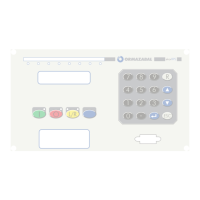IG-150-EN version 04; 03/10/16
107
General instructions
ekor.rps
Protection functions. Description and settings
4.26.2. Setting range (6 tables)
Setting Min Max Step Notes
Enable
YES/NO
Phase restore [A]
0.1 200.0 0.01
Neutral restore [A]
0.1 200.0 0.1
Denite time [s]
0.00 60.0 0.01
Table 4.39. Setting range
These settings can be found in the console on the screen
“overcurrent protection (2)”
4.27. Tap changer locking (50TCL function)
The only purpose of this function is to allow tap changer
locking if the set current value is exceeded.
The settings are the following ones:
1. Enable: YES/NO
2. Locking current threshold: 0.1 A to 200 A
If the biggest of phase currents exceeds the set threshold
the relay programmed as “tap changer locked” is activated
and its correspondent control signal is sent.
4.28. Locking of the protection functions
Each protection function can be blocked by a digital input
or by a logic function (combination of control inputs
and/or signals). See “logic signals programming” in the
conguration section.
The locking programming is done by keyboard/display as
one setting more of the given function.
By console, the programming is done through screens
called “locks”, whose number depends on the optional
functions available in the unit.
4.29. Fault locator
4.29.1. Introduction
The fault locator for singles lines implemented with the
ekor.rps protection processes the information collected on
each fault, thereby returning the estimated distance to the
fault point as a result of its calculations.
The initial data necessary for reaching the nal calculations
are the following:
1. Sample to sample values of the voltage and current
signals collected at the instant that the fault occurs
2. Impedance parameters of the line on which the fault
has occurred.
3. Length of the line.
4. Transformation ratios of the VT and CT of the position
that captured the fault.
The result obtained is the distance to the fault in kilometres.

